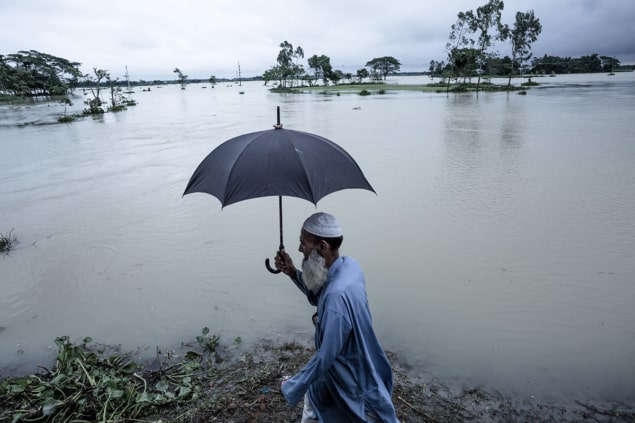This story is part of Covering Climate Now, a global collaboration of more than 250 news outlets to strengthen coverage of the climate story.
If your life and livelihood were threatened by rising sea levels, where would you go and who would help? Robert P Crease reports from a conference on the difficulties of “managed retreat”

Imagine you’re a passenger on an overloaded boat in a storm. You and every experienced person aboard know the ship is swamping. But the captain and crew are incompetent. Bent on the course they think will most profit themselves, they tell you the ship is great. Many passengers find this a relief, thrilled they don’t have to change how they act.
Unfortunately, you and other concerned passengers cannot convince the despicable captain and crew to take action. Had they acted earlier, both ship and cargo could have been saved; now it’s possibly too late. Part of the cargo will have to be heaved overboard to rescue the ship. But how should you choose how much cargo and which bit of it? And what will be the impact on the ship and passengers?
This was the basic situation tackled at a conference held last June at Columbia University in New York, entitled At What Point Managed Retreat? Resilience Building in the Coastal Zone. The storm is global warming; the swamping is its drastic effects; and heaving the cargo is what must be done to preserve anything like the life we now have.
Down, down
The conference was staged by the Earth Institute – a centre at Columbia that takes an interdisciplinary approach to complex looming issues facing the planet and its inhabitants. It attracted an overflow crowd of about 400 people, plus a further 300 who tuned in live online. Participants included social scientists, administrators, educators, activists, elders, journalists, lawyers, philosophers and representatives of non-governmental organizations.
Alex Halliday, the British geochemist who is the institute’s director, conveyed the urgency in his opening remarks. Sea levels are now rising by about 3–4 mm a year, he said, which doesn’t sound like much, but the rate could increase 10-fold. That will hit coastal cities and force hundreds of millions of people to be relocated and destroy trillions of dollars in property and infrastructure. Cascading effects associated with other climate developments will trigger monsoons, river floods, hurricanes, melting glaciers and more. “Sorry to put a damper on the beginning of the meeting,” Halliday said.
Robin Bronen, a lawyer and director of the Alaska Institute for Justice, a non-profit human-rights organization, was next. “I am heartbroken,” she said. “I can barely articulate the level and rapidity of change that I am bearing witness to.” The Arctic is, after all, in the front lines of climate change. In recent winters, temperatures there have risen by 3.5–4 °C, while last March they were 11 °C above the norm – far more than climate models had predicted.
I can barely articulate the level and rapidity of change that I am bearing witness to
Robin Bronen
“That is rapidly changing the snow and ice, which…the indigenous communities that we work with rely on for their hunting and gathering food,” Bronen said, adding that it forces the communities to plan relocations. “What’s causing these changes is my and your greenhouse-gas emissions. If we do not radically cut those greenhouse-gas emissions, we are condemning millions of people to an uncertain future.”
The message conveyed by the 133 speakers who followed was no more upbeat. Though mainly from the US, they were from Australia, Bangladesh, Denmark, Ghana, Oman and Slovakia and half a dozen other countries too. Presentations included a documentary about the impact of Hurricane Sandy on New York City neighbourhoods. A New Hampshire theatre troupe staged a mock discussion between a scientist, homeowner and elected community official in which the audience took part.
Just transition
Few papers addressed the scientific nuts and bolts of coastal flooding. Instead, most talks – and most hallway discussions – concerned social issues. Who should decide which coastal areas are to be relocated? How will decisions be made about when and where to relocate communities, or what support networks will have to be developed and maintained for them? And what about the delicate interactions between the decision-makers and the communities to be relocated? Even these days, when new buildings and roads are built, such interactions can be hugely contentious; the tensions and stakes when it comes to coastal relocations will be much higher, with the interactions taking place on a global scale.
How can we ensure that the most vulnerable communities who will have the least information and poorest infrastructure don’t end up treated the worst?
Robert P Crease
Social-justice issues were also debated. Many waterfront communities on the US eastern seaboard and along the Gulf of Mexico historically were stolen from Native American tribes, some of which have already been relocated several times against their will. How can we ensure that the most vulnerable communities who will have the least information and poorest infrastructure don’t end up treated the worst?

Dealing with a climate emergency
Many threatened regions are now occupied by wealthy landowners whose properties are products of over-development and greed. How can we ensure that the more economically valuable real estate of the top 1%, who after all have by far the most political clout, do not once again receive preferential treatment? How, in other words, can we ensure “just transition”, as one speaker put it?
The critical point
At What Point Managed Retreat? was the first major conference to discuss not the looming danger of climate change, but how to cope with its unfolding. By the end of the three-day meeting, few clear solutions had emerged, though it was an important step forward to recognize social justice as an essential component of any solution.
It was affirming to see that you’re not crazy and that other people are worrying about this
Radley Horton
Some participants were left fearful and depressed, but conference co-organizer Radley Horton told me afterwards that many felt relief and even optimism. “It was affirming to see that you’re not crazy and that other people are worrying about this,” he said to me. “It’s still early days. But it’s encouraging to see people beginning to discuss, proactively, what safer and less vulnerable places might look like.”
At least some passengers see the need to develop a plan for dealing with the vile and immoral actions of the captain and crew.



